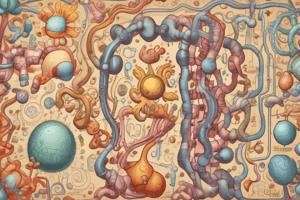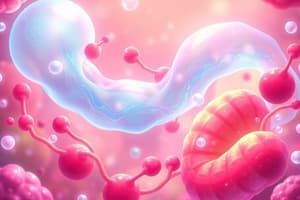Podcast
Questions and Answers
What is the primary source of fatty acids used by the body?
What is the primary source of fatty acids used by the body?
- Glycogen breakdown
- De novo lipogenesis
- Diet (correct)
- Protein degradation
Where does the de novo synthesis of fatty acids take place?
Where does the de novo synthesis of fatty acids take place?
- Mitochondria
- Cytosol (correct)
- Endoplasmic reticulum
- Golgi apparatus
What is the role of HCO3 in lipogenesis?
What is the role of HCO3 in lipogenesis?
- End product
- Cofactor
- Substrate
- Source of CO2 (correct)
Which of the following tissues is NOT a primary site for fatty acid synthesis?
Which of the following tissues is NOT a primary site for fatty acid synthesis?
What is the primary purpose of de novo lipogenesis in the body?
What is the primary purpose of de novo lipogenesis in the body?
What is the end product of de novo lipogenesis?
What is the end product of de novo lipogenesis?
What is the purpose of citrate in regulating Acetyl CoA carboxylase?
What is the purpose of citrate in regulating Acetyl CoA carboxylase?
Which kinase is activated by cyclic AMP (cAMP)–dependent protein kinase A (PKA)?
Which kinase is activated by cyclic AMP (cAMP)–dependent protein kinase A (PKA)?
What happens to Acetyl CoA carboxylase in the presence of insulin?
What happens to Acetyl CoA carboxylase in the presence of insulin?
What is the effect of a high-fat, low-carbohydrate diet on Acetyl CoA carboxylase synthesis?
What is the effect of a high-fat, low-carbohydrate diet on Acetyl CoA carboxylase synthesis?
What is the role of Adenosine monophosphate–activated protein kinase (AMPK) in regulating Acetyl CoA carboxylase?
What is the role of Adenosine monophosphate–activated protein kinase (AMPK) in regulating Acetyl CoA carboxylase?
What is the transcription factor that upregulates Acetyl CoA carboxylase synthesis in response to carbohydrate, specifically glucose?
What is the transcription factor that upregulates Acetyl CoA carboxylase synthesis in response to carbohydrate, specifically glucose?
What is the primary mechanism by which metformin lowers plasma TAG?
What is the primary mechanism by which metformin lowers plasma TAG?
What is the role of 4'-phosphopantetheine in fatty acid synthesis?
What is the role of 4'-phosphopantetheine in fatty acid synthesis?
How many NADPH molecules are required for the synthesis of one molecule of palmitate?
How many NADPH molecules are required for the synthesis of one molecule of palmitate?
What is the primary source of NADPH for fatty acid synthesis?
What is the primary source of NADPH for fatty acid synthesis?
What is the function of AMPK in the treatment of type 2 diabetes?
What is the function of AMPK in the treatment of type 2 diabetes?
What is the function of the acyl carrier protein (ACP) domain in FAS?
What is the function of the acyl carrier protein (ACP) domain in FAS?
What is the byproduct of cytosolic conversion of malate to pyruvate?
What is the byproduct of cytosolic conversion of malate to pyruvate?
What is the source of cytosolic NADH required for the reduction of OAA to malate?
What is the source of cytosolic NADH required for the reduction of OAA to malate?
What is the function of ATP citrate lyase?
What is the function of ATP citrate lyase?
What is the primary end product of fatty acid synthase activity?
What is the primary end product of fatty acid synthase activity?
What is the function of fatty acyl CoA desaturases?
What is the function of fatty acyl CoA desaturases?
Where does the elongation of VLCFAs over 22 carbons occur?
Where does the elongation of VLCFAs over 22 carbons occur?
What is the primary product of the first double bond insertion in fatty acid desaturation reactions?
What is the primary product of the first double bond insertion in fatty acid desaturation reactions?
What is the functional group involved in the esterification of fatty acids to glycerol?
What is the functional group involved in the esterification of fatty acids to glycerol?
Why are polyunsaturated ω-6 linoleic acid and ω-3 linolenic acid considered nutritionally essential?
Why are polyunsaturated ω-6 linoleic acid and ω-3 linolenic acid considered nutritionally essential?
What is the term for an acylglycerol that is solid at room temperature?
What is the term for an acylglycerol that is solid at room temperature?
What is the direction of numbering of carbon atoms in fatty acids, when starting from the methyl end?
What is the direction of numbering of carbon atoms in fatty acids, when starting from the methyl end?
What is the direction of numbering of carbon atoms in fatty acids, when starting from the COOH group?
What is the direction of numbering of carbon atoms in fatty acids, when starting from the COOH group?
Flashcards are hidden until you start studying
Study Notes
Lipogenesis (De Novo Synthesis of Fatty Acids)
- Lipogenesis occurs in the cytosol of many tissues, including liver, kidney, brain, lung, mammary gland, and adipose tissue
- Fatty acid synthesis occurs primarily in liver and lactating mammary glands
- Lipogenesis necessitates substrate: Acetyl CoA, cofactors: NADPH, ATP, Mn2+, Biotin, and source of CO2: HCO3 (Bicarbonate)
- End product: Palmitate (Palmitic acid), a free fatty acid
Acetyl CoA Carboxylase (ACC) Regulation
- ACC is the rate-limiting and regulated step in fatty acid synthesis
- Allosterically activated by citrate, and allosterically inactivated by palmitoyl CoA (the end product of the pathway)
- Reversible phosphorylation by AMP-activated protein kinase (AMPK) and covalent phosphorylation by PKA
- In the presence of hormones like epinephrine and glucagon, ACC is phosphorylated and inactive, while in the presence of insulin, ACC is dephosphorylated and active
Fatty Acid Synthase (FAS)
- Catalyzes the remaining series of reactions in fatty acid synthesis
- Multifunctional enzyme with 6 different enzymic domains plus a 4'-phosphopantetheine-containing acyl carrier protein (ACP) domain
- Process involves the addition of 2 carbons from malonyl CoA to the carboxyl end of a series of acyl acceptors
Reductant Sources for Fatty Acid Synthesis
- One palmitate synthesis requires 14 NADPH, a reductant (reducing agent)
- Pentose phosphate pathway is a major supplier of NADPH
- Cytosolic conversion of malate to pyruvate, in which malate is oxidized and decarboxylated by cytosolic malic enzyme (NADP+-dependent malate dehydrogenase), also produces cytosolic NADPH (and CO2)
Interrelationship between Glucose Metabolism and Palmitate Synthesis
- Pyruvate carboxylase and pyruvate dehydrogenase are involved in the interrelationship between glucose metabolism and palmitate synthesis
Elongation of Fatty Acids
- Palmitic acid can be further elongated by addition of 2 carbon units to the carboxylate end in smooth endoplasmic reticulum
- Elongation requires a system of separate enzymes rather than a multifunctional enzyme
- Brain has additional elongation capabilities, producing very long chain fatty acids (VLCFAs) over 22 carbons
Chain Desaturation
- Fatty acyl CoA desaturases are present in smooth endoplasmic reticulum (SER)
- Desaturation reactions require oxygen, NADH, cytochrome b5, and its FAD-linked reductase
- The first double bond is typically inserted between carbons 9 and 10, producing primarily oleic acid, 18:1(9), and small amounts of palmitoleic acid, 16:1(9)
Triacylglycerol Synthesis and Storage
- Mono-, di-, and triacylglycerols consist of one, two, or three molecules of fatty acid esterified to a molecule of glycerol
- Fatty acids are esterified through their carboxyl groups, resulting in a loss of negative charge and formation of neutral fat
- An acylglycerol that is solid at room temperature is called a fat
Studying That Suits You
Use AI to generate personalized quizzes and flashcards to suit your learning preferences.




